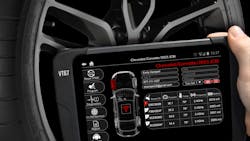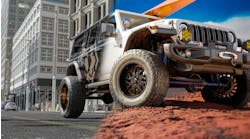Every tire dealer understands the importance of tire pressure monitoring systems (TPMS) to their customers’ vehicles and the importance of their technicians understanding TPMS sensors and reprogramming.
While most technicians are comfortable performing TPMS service on regular tires, high performance (HP) and ultra-high-performance (UHP) tires may make things trickier.
Officials from 31 Inc., ATEQ TPMS Tools LC, Autel North America, Bartec USA LLC and Schrader TPMS Solutions weigh in on the best practices to follow when servicing TPMS on HP/UHP tires.
31 Inc.’s TPMS/Technologies Marketing Manager John Rice says that HP and UHP tires are often low-profile tires. And more of these tires are coming from the factory as original equipment on cars. These often have clamp-in style TPMS sensor.
“This means specific service requirements,” says Rice.
“Low-profile tires have shorter sidewall heights, so when scanning/activating TPMS sensors as part of recalibrating, it becomes more difficult because it is important to position the TPMS tool over the sidewall of the tire adjacent to the sensor (and) not directly over the sensor.”
“Clamp-in style TPMS sensors have serviceable parts — nuts, core, cap, grommet — that should be replaced any time a tire is removed from the wheel,” he notes.
“When demounting low-profile tires, special care should be taken to properly position the mount head behind the valve stem to avoid damaging the TPMS sensor.
“Similarly, when mounting these tires, the sensor should be positioned 180-degrees from the mount head to avoid damaging the sensor.”
Rice says it is always important for technicians to remember the basics when it comes to performing TPMS service on any tire — whether it be a HP tire or UHP tire, or a more traditional all-season tire.
He explains that it’s critical to “test before you touch” — meaning before performing any service, the technician should check the TPMS sensors so they can identify any sensors that are not working properly.
Another tip is to keep tools updated and charged.
“There isn’t anything more frustrating than being in the middle of servicing your customer’s vehicle, reaching for a TPMS tool and realizing the battery is dead,” says Rice. “Charge your tools at least once a week.”
Rice encourages technicians to keep up with software updates in order to service TPMS more easily.
“A tool that is not updated can be just as frustrating” as a tool that hasn’t been charged.
ATEQ’s Mike Rose, the company’s OEM and industrial sales manager, says it is important to “understand that the car’s TPMS was designed to work with the original equipment (OE) wheel package.
“Therefore, following industry best practices to ensure the sensor’s angle remains close to the OE fitment will benefit the system overall.”
Rose adds that this is extra-important to remember because there are more and more tire pressure monitoring systems ending up on vehicles.
“Understanding what can be affected when components are altered or changed is critical in making sure the service performed on the vehicle will work as intended,” says Rose.
According to Rose, the biggest thing to keep in mind regarding TPMS and performance vehicles is the speed at which the car’s wheels are spinning.
“With these vehicles being able to reach speeds in excess of 100 mph, the need for a valve stem that can withstand the additional force is required,” he says. “This is why you see these types of vehicles being fitted with what is commonly known as ‘high-speed’ valve stems.
“Depending on what the vehicle manufacturer is looking to achieve, these stems can be made of different rubber compounds or even a metal valve stem.”
When things also can become “interesting” is after an alternate or aftermarket tire/wheel package has been installed and technicians have to “verify that the sensor location and angle stay consistent with the OE fitment.”
Rose says this is one reason why aftermarket sensor companies offer different sensor configurations or alternative mounting hardware — “to keep up with the changes.”
Autel’s John Amato, the firm’s director of training, says that to understand TPMS on HP/UHP tires, the subject must first be broken down into two categories — HP/UHP street tires and motorsport applications.
“With street applications, it is important to properly carry out diagnostic and relearn procedures while paying particular attention to the placard pressure,” says Amato.
“Underinflated, low-profile tires are more susceptible to pinch flats, sidewall (damage) or wheel damage. Remember, there is less room for deflection in the sidewall with lower aspect ratio tires.”
In both street and motorsports applications, the accuracy of the tire pressure being reported by the system is “crucial in meeting the (vehicle’s) performance goals.
“Pressure must always be checked with a properly calibrated pressure gauge to ensure accuracy (as) driver safety is paramount in motorsports,” says Amato.
“Clamp-in valves are preferred in these applications, as they are more durable than rubber at high speeds. Make sure that the valve nut and stem mounting screw are torqued to factory specifications.”
He says it is also important to double-check the placard tire pressure value against the load range of the tire because HP/UHP tires often run at higher pressure to increase vehicle handling and stability.
“Properly executed TPMS service and repair procedures lower the driver’s risk of having a failure on the road,” notes Amato, who adds that “250,000 accidents occur in the United States per year due to low tire pressure.”
In addition, Amato says it is important to keep in mind that tire pressure monitoring systems are designed and engineered to work within “specific tolerances.”
Moving the location of the sensor even by a few inches can affect sensor transmission and the effectiveness of the module.
Bartec CEO Scot Holloway maintains that HP/UHP tires require high-performance TPMS service and parts.
He says there are three things technicians need to consider when servicing TPMS on HP and UHP tires: performing the necessary system diagnostics, installing the proper wheel sensors and making sure the vehicle is properly calibrated.
“System diagnostics include a baseline inspection of the TPMS sensors and a read from the TPMS control module,” Holloway notes.
The technician should be looking for any fault codes and should “always inform the customer of any system issues or faults prior to beginning work. Only use replacement parts that are rated for HP/UHP applications.
“High performance also applies to aesthetics, as well. Does the valve stem match the wheel? When in doubt, use aluminum stems with the sensor because aluminum stems are mechanically attached to the wheel.”
Aluminum stems also are best suited for higher air pressure levels and speed ratings.
And don’t forget function, says Holloway.
“Will it work on this application? Will it fit this wheel type? These are key questions techs need to be asking themselves. It is important to pick a sensor that fits the look and (function) of the wheel and tire.”
Schrader Global Technician Training Manager Yanick Leduc recommends keeping a close eye on the type of wheel you are fitting the sensor to.
Leduc says in many cases, the wheel is the main differentiating factor when it comes to OE and aftermarket tire/wheel packages.
“With low-profile tires or rims (that have) a very large offset, choosing the wrong sensor fitment can lead to sensor damage during tire mounting or dismounting or even (cause) sensor centrifugal distortion on high speed,” he explains.
He adds that there are three “golden rules” that technicians should follow regarding TPMS sensor and valve fitment.
“Number one, the valve should not extend over its contour. Number two, the sensor body should remain parallel to the bottom of the rim without being in contact with the rim. And number three, the angle of the sensor with the valve should be positioned so that the sensor should not extend over the rim hump.”








